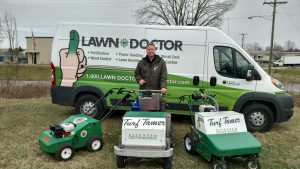 Want to achieve the lawn of your dreams? Then aerating is essential. This is especially true if you have clay soil or your lawn experiences heavy foot traffic. If you don’t aerate, then soil gets compacted, squeezing roots and causing them to suffocate. Likewise, thatch builds up on the surface so water and fertilizer can’t pass through to the root zone. The good news is that with aeration from Lawn Doctor of South Bend-Granger-Mishawaka-Elkhart, you can cut down on compaction and thatch, and get your lawn breathing again.
Want to achieve the lawn of your dreams? Then aerating is essential. This is especially true if you have clay soil or your lawn experiences heavy foot traffic. If you don’t aerate, then soil gets compacted, squeezing roots and causing them to suffocate. Likewise, thatch builds up on the surface so water and fertilizer can’t pass through to the root zone. The good news is that with aeration from Lawn Doctor of South Bend-Granger-Mishawaka-Elkhart, you can cut down on compaction and thatch, and get your lawn breathing again.
How Does the Lawn Aeration Process Work?
Aerating is simply the process of opening up your lawn and loosening the soil. While there are different methods you can use, Lawn Doctor of South Bend-Granger-Mishawaka-Elkhart relies on core aeration. With this approach, specialized equipment cores out or removes small plugs of soil and grass from around your lawn. This creates pathways for air, water, and fertilizer to flow more freely and penetrate deep into the soil. As a result:
- Roots grow stronger
- Heat is better absorbed
- Fertilizer and water are absorbed more efficiently
In the weeks and months after aeration, you’ll notice a thicker, more vibrant lawn.
Does My Lawn Need Aeration?
You don’t have to be a lawn care expert to look for signs of soil compaction and thatch build-up. Just take a screwdriver or a shovel and try digging it into the ground. If you encounter a lot of resistance, then your soil is compacted and should be aerated. Other common signs of soil compaction include thin growth, bare spots, and standing puddles of water. In addition, if your lawn has clay soil or if you park vehicles on it, then compaction is more likely to occur.
When Should Aeration Be Performed?
At Lawn Doctor of South Bend-Granger-Mishawaka-Elkhart, we know that performing aeration at the wrong time of the year can lead to a host of problems, including a weed infestation. It’s important, instead, to aerate just before your grass type’s peak growing season. That way, the holes will fill in quickly with healthy, new growth. For cool season grass, like ryegrass, early spring and fall are ideal for aeration. For warm season grass, like Buffalo, end of spring is the best time to aerate.
How Can Lawn Doctor of South Bend-Granger-Mishawaka-Elkhart Help?
If you’re like most homeowners in the South Bend and Granger areas, you don’t have the time or know-how to perform lawn aeration yourself. That’s where Lawn Doctor of South Bend-Granger-Mishawaka-Elkhart comes in. For the best results, we can combine our aeration services with overseeding to produce the thick, healthy lawn you’ve been dreaming of.
To schedule your free lawn aeration consultation, call Lawn Doctor of South Bend-Granger-Mishawaka-Elkhart today at 574.318.3233.
For more information about our lawn aeration services, click here.
